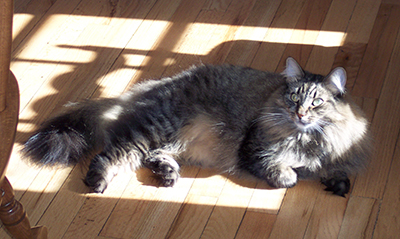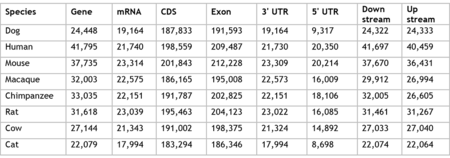 Earlier this month, an international effort* led by Stephen J. O'Brien at the Oceanographic Center, Nova Southeastern University, Ft. Lauderdale, Florida reported the complete genomic sequencing of the domestic cat, Felix catus. The report, entitled "Annotated features of domestic cat – Felis catus genome," was published in GigaScience 2014, 3:13 (August 5, 2014).
Earlier this month, an international effort* led by Stephen J. O'Brien at the Oceanographic Center, Nova Southeastern University, Ft. Lauderdale, Florida reported the complete genomic sequencing of the domestic cat, Felix catus. The report, entitled "Annotated features of domestic cat – Felis catus genome," was published in GigaScience 2014, 3:13 (August 5, 2014).
The study reports sequencing of a female Abyssinian cat named Cinnamon, a mixed-breed cat from Russian named Boris, and Sylvester, a wildcat ancestor of domestic cats. Most significantly, the report showed that domestic cats have retained "a highly conserved ancestral mammal genome organization" in comparison with ancestral cats (see Driscoll et al., 2007, "The near eastern origin of cat domestication," Science 317: 519–23). Both species, F. catus and Felix silvestris silvestris, have 38 chromosomes, 18 pairs of autosomes, and two pairs of dimorphic gender-determining chromosomes.
The report is replete with arcane details of the cat genome, including the discovery of:
• 217 loci of endogenous retrovirus-like elements (amounting to 55.7% of the entire genome, comprised of long interspersed elements (LINEs), short interspersed elements (SINEs), satellite DNA, retroviral long terminal repeats (LTRs) and "others");
• 21,865 protein coding genes (open reading frames or ORFs), detected by comparison with eight mammalian genomes (from human, chimpanzee, macaque, dog, cow, horse, rat, and mouse);
• 99,494 "new" single nucleotide polymorphisms (SNPs), in addition to 3,078,438 previously identified SNPs;
• 8,355 new insertion/deletion events (indels);
• 743,326 evolutionarily constrained elements (ECEs);
• 3,182 microRNA homologues;
• 25 novel families of complex tandem repeat elements;
• 53,710 short terminal repeat (STR) loci;
as well as 176 kb of mitochondrially derived DNA and 125 kb of partial feline retrovirus-derived DNA. In addition, 10.5% of cytosine residues are methylated in the cat genome.
There was also extensive evidence of regions of "recent" autosomal segmental duplications. Specifically:
Among all variants 24.6% (693,428 SNVs and 122,333 indels) were heterozygous in Felis silvestris. Between the genomes of Felis catus and Felis silvestris some 2.9 million (2,847,548) single nucleotide variants and ~1.9 Mbp of insertions and deletions were detected. Observed differences were significantly fewer compared to difference between human and chimpanzee genomes (~35 million SNV and ~90 Mbp of indels).
The report also contains extensive comparison between domestic cats and other species ("reference genomes") in terms of gene numbers, using genes with the longest the longest mRNA and corresponding coding sequences (click on table to expand).

The intriguing finding that modern domestic cats are more similar to their wildcat forebears than are dogs to wolves (or humans and chimpanzees, for all the touted 98% similarity between simian and human genomes) is not explained in the report. Regarding dogs, comparison of breed types provides some hints: while there are about 41 breeds of domestic cat, there are 339 breeds of dogs, sorted into 10 groups (terriers, retrievers, pointer/setters, hounds, companion or "toy" dogs, "herding" dogs like sheepdogs, mastiffs, non-sporting dogs like Dalmatians and bulldogs, sporting dogs like spaniels, and working dogs like the Akita and Alaskan Husky). These dogs vary in overall size, leg length, muzzle shape, fur length and density, muscularity, and temperament, among other attributes. Many of the features of these dog breeds have been selected by human breeding practices for traits and features having at least some genetic component. In addition, the process of domesticating a dog from its wolf ancestors involved changing its personality from human predator to human companion and allowed the dog to permit humans to take the "alpha" role of pack leader.
Cats, on the other hand do not vary that much in size and in fact show most of their variation in coat and eye color and coat pattern. There also have been many fewer behavioral changes in domestic cats than in dogs, as evidenced by cats' (in)famous independence. While these are merely speculations, it seems likely that the domestication process required far fewer genetic adaptations in cats than it seems were required in dogs, and thus their modern genomes retain much closer similarity to the ancestral European wild cat than do dogs to their wolfish ancestors.
Finally, for the cognoscenti (and those with a low sense of humor), the authors also report their development of a cat genome browser, designated Genome Annotation Resource Field or GARField (groan).
* Other members of the team included scientists from the Theodius Dobzhansky Center for Genomic Bioinformatics, St. Petersburg State University, St. Petersburg RU (Gaik Tamazian, Serguei Simonov, Pavel Dobrynin, Alexey Makunin, Anton Logachev, Aleksey Komissarov, Andrey Shevchenko, Vladimir Brukhin, Nikolay Cherkasoy, Anton Svitin, Klaus-Peter Koepfli, and Joan Pontius); Laboratory of Neurogenetics, NIAAA, Rockville, MD USA (Carlos A Driscoll, Kevin Blackstone, Cristina Barr and David Goldman); CIIMAR – Interdisciplinary Center of Marine and Environmental Research, University of Porto, Proto PT (Agostinho Antunes); Department of Animal and Food Science, Veterinary Molecular Genetics Service, Universitat Autonoma de Barcelona, Barcelona ES (Javier Quilez); IBE, Institute of Evolutionary Biology, Universitat Pompeu Fabra-CSIS, PRBB, Barcelona ES (Belen Lorente-Galdos and Tomas Marques-Bonet); Department of Computer Engineering, Bilkent Univesity, Ankara TK (Can Alkan); Laboratory of Genomic Diversity, Frederick National Laboratory for Cancer Research, Frederick MD USA (Marylin Menotti-Raymond and Victor David); and the Department of Veterinary Medicine and Surgery, College of Veterinary Medicine, University of Missouri, Columbia MO (Krsitina Narfstrom).
For additional information regarding this and other related topics, please see:
• "Leg Length Variation in Dogs and its Relevance to Human Mutations," August 31, 2009
• "The Genetic Basis of Coat Variation in Dogs," August 30, 2009
• "From Toy Poodle to Rottweiler: Why Is Fido So Small (or Large)?" April 9, 2007